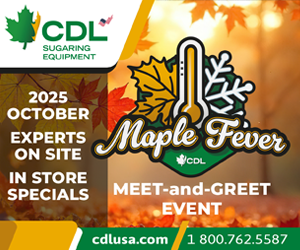UVM Proctor Page
Grant awarded to examine tapping practices
10-year study will use about 100 trees, look at gravity systems and high-vacuum apparatus
By PAUL POST |
To Tim Perkins, maple tapping is kind of like taking out a loan.
You can opt for high yield now on smaller trees and wind up paying high “interest rates” or adopt more sustainable practices with a tree’s long-term health in mind that will keep it productive and profitable for decades to come.
His presentation, “A Reassessment of Tapping Guidelines,” was one of the most heavily-attended sessions at this year’s 18th Annual New York Maple Producers Conference, held Jan. 4-5 in Verona, N.Y.
“Original tapping guidelines were based on the 7/16-inch spout,” said Perkins, Phd, director of the University of Vermont’s Proctor Maple Research Center. “Small spouts 1/4, 19/64, 5/16) are now much more common. Plus, you get much higher tap yields using new technology such as pumps, vacuums, tubing. But there’s been no consideration of the carbohydrate (sugar) extraction effects on growth rates; no consideration given to the trade-offs in yield.”
“How much sugar is being extracted? How does that effect the health of the tree? What are the trade-offs? If that’s hurting the tree, how much? If there are gray areas, we want to make them more black and white.”
Using a highly-detailed system of charts and mathematical analysis, Perkins showed how variables such as taphole diameter, taphole depth, dropline length and number of taps can affect yield and either harm or promote a tree’s sap production.
“If you’re having a problem of too much non-functional wood, you have to make a change,” he said. “Maple producers should monitor the percentage of non-functional wood and adjust their tapping regime as warranted. You have to make sure your trees are healthy.”
His UVM program recently obtained a grant from the Chittenden County (Vt.) Maple Sugarmakers Association to conduct a 10-year study of tapping practices, using about 100 trees. Some trees will be tapped with a gravity system, others using high-vacuum apparatus. Some will be left as a control group to see how they grow compare to trees that have been tapped using the two different methods.
The study will begin in 2014.
“It’s going to take at least five years before we get any results,” Perkins said. “Trees that are tapped tend to grow just a little bit slower.”
That’s an acceptable part of doing business. Using science-based, best practices, producers have to decide how much growth they’re willing to sacrifice for short-term gains.
“How much sap removal is too much?” Perkins asked.
Using high-yield methods, up to 12 percent of a six-inch diameter tree’s soluble sugar can be extracted. “But you don’t want to pay high interest rates,” he said. “Tapping small trees is probably only in very limited circumstances a good idea. They aren’t going to grow as much.”
In contrast, the same high-yield procedures might take less than one percent of a mature, 18-inch diameter tree’s sap.
Using photos and illustrations, Perkins showed how each tap results in a certain amount of non-functional wood inside the tree. When drilling holes, producers know if they’ve hit bad wood if it’s a drier, dark yellowish color instead of moist, fresh white wood.
“We want to manage things,” he said. “If we get to the point where a tree is non-functional, it’s unproductive. How much of a tree is functional? How much is non-functional because it’s been tapped. As the problem gets worse, it compounds.”
Smaller, shallower taps will minimize negative impacts. Also, longer drop lines -- up to three feet long -- expand the area that can be tapped meaning that holes won’t be so tightly spaced. You get the same amount of non-functional wood, but there’s more functional wood available.
A short drop line costs less for plastic. “However, you’re not going to get as much sap out of that tree if you’ve got a lot of non-functional wood in it,” Perkins said. “Those decisions are short-sighted in a way.”
The whole focus of his presentation was to show producers how different choices affect the sustainability of tapping. Such considerations are especially important for young producers, or those just getting into the business who want to keep their sugarbush healthy and productive for many years to come.
A study evaluating the percentage of sugar reserve being removed from trees was last done 1903, Perkins said. Obviously, tapping technology and procedures have changed greatly since then, which explains why his program’s upcoming new study is so important.
He also discussed the pros and cons of multiple taps. Obviously, a second or even third tap will yield more sap, but not as much perhaps as people might think.
“At what point is it worth putting in a second tap hole?” Perkins said. “You’re not going to get double the amount of sap.”
With a 16-inch diameter tree, a second hole will produce 50 percent more sap than one hole. With a 19-inch tree, about 66 percent more can be expected.
However, the drawback is that each hole also produces that much more non-functional wood. “You have to think of the functional diameter, not just the size of the tree,” Perkins said.
The whole idea is to gauge how much functional wood will be available in 10, 15 or 25 years based on the different factors a producer has to choose from such as taphole size, depth and collection method -- gravity fed versus high-yield vacuum.
It’s a balancing act that every producer has to navigate himself or herself, as they weigh their desire for short-term monetary gain and long-term business growth.
“You treat your trees right and you’ll be happy,” Perkins said.
February 2013
































